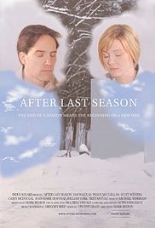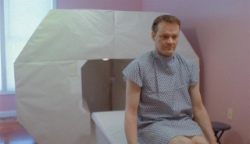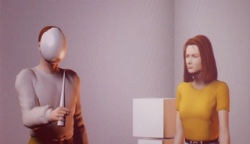
 I’m deeply concerned about you, After Last Season. Are you all right? I fear that something is really, really wrong. Please know that I am here for you. What can I do to help?
I’m deeply concerned about you, After Last Season. Are you all right? I fear that something is really, really wrong. Please know that I am here for you. What can I do to help?
After Last Season is written, directed, shot and produced by mystery man Mark Region, although those verbs do not accurately describe his actions. His movie is independent, in financing and of logic. Cineasts who salivate over random, static cutaways to improperly framed pieces of furniture are in for a real treat. Everyone else risks an aneurysm. Here are just five reasons why:
• All of the scenes — whether set inside an apartment building, a medical facility, a college classroom and a corporation’s headquarters — appear to have been staged in someone’s house.
• Walls, doors and objects are covered in so much paper, the movie is environmentally unsound.
• Some of those sheets of paper are signs or printouts, suggesting that a healthy line item in the budget was reserved for Kinko’s.
• Several props were constructed from cardboard (and then wrapped in more paper, natch), including an MRI scanner.
• Region claims his budget was $5 million. The only way that figure can be true is if one or more parties, wanting nothing to do with the project, priced themselves way beyond the boundaries of reason, and Region said, “Okay.”
 Once Region realizes his story perhaps should at least resemble one, if only tangentially, here is what “happens,” although it takes a half-hour to reach this point: Matt (Jason Kulas, Slaughter Weekend) and Sarah (Peggy McClellan, The Pink Panther 2), meet to conduct a psychology experiment. We know this because Matt makes good on his assurance to Sarah that he will put a sign on the door, and it reads, “PSYCHOLOGY EXPERIMENT.” I mention that detail only because with Matt’s action, viewers are gifted with an actual moment of lucidity. (Unrelated, one of dozens of signs to be glimpsed throughout announces, “PINEAPPLE CLUB.” Rule 1: Do not talk about Pineapple Club.)
Once Region realizes his story perhaps should at least resemble one, if only tangentially, here is what “happens,” although it takes a half-hour to reach this point: Matt (Jason Kulas, Slaughter Weekend) and Sarah (Peggy McClellan, The Pink Panther 2), meet to conduct a psychology experiment. We know this because Matt makes good on his assurance to Sarah that he will put a sign on the door, and it reads, “PSYCHOLOGY EXPERIMENT.” I mention that detail only because with Matt’s action, viewers are gifted with an actual moment of lucidity. (Unrelated, one of dozens of signs to be glimpsed throughout announces, “PINEAPPLE CLUB.” Rule 1: Do not talk about Pineapple Club.)
In the experiment, Matt and Sarah each affix a computer chip resembling a yellow Chiclet on their right temple. This connects them psychically, or something. As long as Sarah keeps her eyes closed, Matt can see what she’s thinking, or something. He attempts to guide her, like telling her to think of a letter; she answers, “From the alphabet?” Her thoughts give way to lonnnnnnnnnng stretches of rudimentary computer animation depicting slowwwwwwwwwwly floating shapes that, if I didn’t know any better, could come from stock footage tagged “Geometry on Parade.”
 Sarah mentions she can see murders before they happen, or something. Before long, we’re shown animated visions of a pinball-faced man with a knife emerge from the wall, as if The Sims: Homicide Edition existed. Then, back in the experiment room, Matt and Sarah hear a Voice from Beyond; a ruler floats; furniture moves on its own; they get sliced by an unseen force; and then a real guy with a real knife enters, but he’s felled by a flying office chair, or something. I suppose I could have had a psychotic break.
Sarah mentions she can see murders before they happen, or something. Before long, we’re shown animated visions of a pinball-faced man with a knife emerge from the wall, as if The Sims: Homicide Edition existed. Then, back in the experiment room, Matt and Sarah hear a Voice from Beyond; a ruler floats; furniture moves on its own; they get sliced by an unseen force; and then a real guy with a real knife enters, but he’s felled by a flying office chair, or something. I suppose I could have had a psychotic break.
It is ironic that a movie so concerned with the scientific topic of brain activity can have none of its own. Bearing a title that doesn’t even make sense, After Last Season operates from a plane of reality different from our own, because I suspect Region may do the same. Characters aren’t established; they simply appear, and most of them serve no purpose, unless Region simply wanted society to absorb his viewpoints on seafood allergies, lecture the audience on magnetic resonance imaging and/or bear witness to the painstaking, real-time conflict of two people trying to agree upon a weekday to meet: Dammit, Tuesday or Wednesday, hmmm?
Like an unmeasured mix of Minority Report, delusional disorder, Poltergeist, a schizophrenia diagnosis, The Invisible Man and Rohypnol dreams, the film may be an anti-film; in fact or in theory, it comes as close to that as my near five-decade existence has encountered. Blessedly Region’s lone effort to date, After Last Season is indescribable psychobabble, a masterstroke of stroke symptoms, the 35mm equivalent of an anus, incompetence cranked to 11 and, finally, Tommy Wiseau’s The Lawnmower Man. Or something. —Rod Lott
